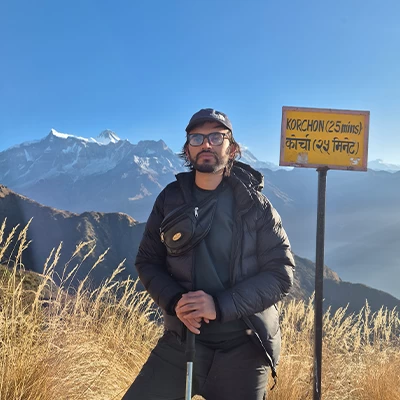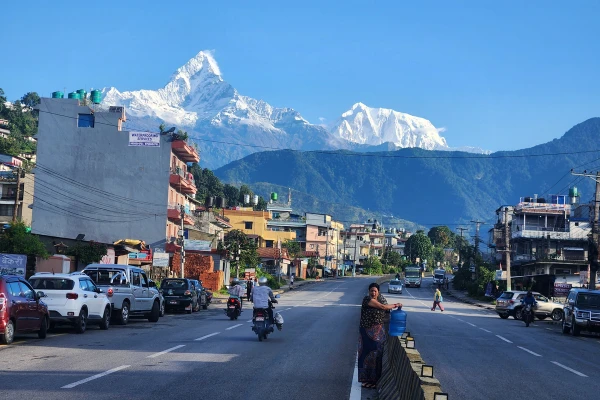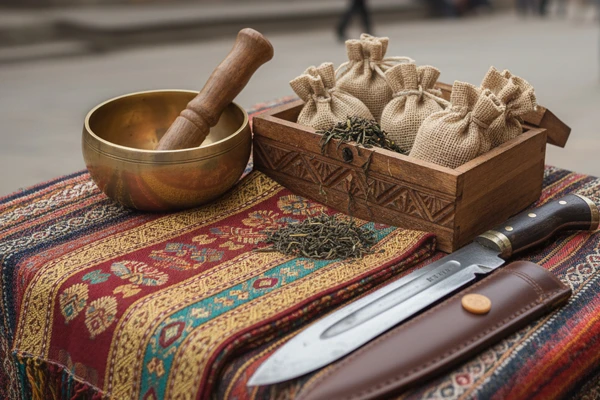Kori Himal Trek Highlight
A newly emerging trail with pristine landscapes, far from crowded tourist routes.
Panoramic vistas of Lamjung Himal (6,988 m), Annapurna II (7,937 m), Machhapuchhare Mount Fishtail (6,993 m), and Manaslu (8,156 m).
Trek through oak and rhododendron forests, with vibrant blooms in spring.
Experience the unique traditions of Buddhist and Bon Po communities in remote villages.
Perfect for beginners and experienced trekkers alike (easy to moderate challenge).
Pass through charming settlements like Tangting and Sikles, offering warm hospitality.
Uninterrupted Himalayan panoramas from high ridges.
Spot rare species in the dense forests and alpine meadows.
Typically 5-7 days, making it ideal for those with limited time.
Kori Himal Trek Itinerary
Day | Route | Altitude (m) | Trekking Time |
1 | Pokhara to Sikles | 822m → 1,980m | 4-5 hrs (drive) |
2 | Sikles to Hugu Goth | 1,980m → 2,016m | 4-5 hrs |
3 | Hugu Goth to Nohtha | 2,016m → 3,000m | 5-6 hrs |
4 | Nohtha to Kori Danda | 3,000m → 3,800m | 4-5 hrs |
5 | Kori Danda to Sikles | 3,800m → 1,980m | 6-7 hrs |
6 | Sikles to Pokhara | 1,980m → 822m | 4-5 hrs (drive) |
Your trek starts with a thrilling off-road ride from Pokhara to Sikles, passing through rugged trails, lush forests, and terraced farmlands. Upon arrival, immerse yourself in the rich Gurung culture of Sikles, visiting the ancient Chili Kohinbo Temple to learn about the Bon Po religion.
The next day, trek through enchanting oak and rhododendron forests, soaking in breathtaking views of Machhapuchhre, Annapurna II, and Lamjung Himal as you ascend to Hugu Goth, a serene herder’s settlement. From there, the trail climbs steeply into alpine terrain, crossing wooden bridges and winding through pine and fir forests, keep an eye out for wildlife like the Himalayan Thar or the colorful Danfe bird.
The highlight awaits at Kori Danda, a panoramic viewpoint rivaling Poon Hill, where you’will witness sunrise over the Annapurna and Manaslu ranges. Explore the lush meadows of Thulake (optional detour) before descending back to Sikles through cascading waterfalls and suspension bridges.
Finally, bid farewell to the mountains with a scenic jeep ride back to Pokhara, where you can unwind by Phewa Lake and celebrate your Himalayan journey.
Are you curious about the Kori Himal distance?
The Kori Himal Trek covers a total hiking distance of approximately 40 kilometers (round trip), spread over 4-5 days of trekking. The route starts from Sikles village, winding through dense rhododendron forests, alpine meadows, and rugged trails before reaching the breathtaking Kori Danda viewpoint (3,800m). While the distance may seem moderate, the real challenge lies in the elevation gain, climbing nearly 2,000 meters from Sikles to the summit. The return follows the same path, making it a compact yet rewarding adventure. Whether you are a beginner or an experienced trekker, the Kori Himal distance is manageable, but the stunning Himalayan vistas make every step worth it!
What permits are required for the Kori Himal Trek?
You only need one permit to trek the Kori Himal route. You only need the Annapurna Conservation Area Permit (ACAP). Since the trek falls within the Annapurna Conservation Area, this permit is mandatory for all trekkers.
You can get the ACAP permit at the Nepal Tourism Board (Kathmandu) or the ACAP counter in Pokhara before starting your trek. Carry passport copies and passport-sized photos for a smooth process. Since Kori Himal is a less crowded trail, you won’t need additional permits like TIMS.
What is the best time to visit Kori Himal?
The best time to trek Kori Himal is during spring (March to May) and autumn (September to November) when the weather is stable, skies are clear, and mountain views are at their most spectacular.
In spring, the trail comes alive with blooming rhododendron forests (Nepal’s national flower) painting the hills in vibrant reds and pinks, while temperatures range from 10°C to 20°C during the day. This season also offers fewer crowds compared to the more popular Annapurna routes.
Autumn, especially October and November, is another ideal window, with crisp air, post-monsoon clarity, and unobstructed Himalayan panoramas. Daytime temperatures hover around 12°C to 18°C, dropping below freezing at higher altitudes (like Kori Danda). Monsoon (June-August), trails become slippery, and winter (December-February), when heavy snow may block high passes.
For solitude and wildflowers, choose late monsoon (June-July); for perfect mountain photography, opt for autumn’s golden light.
What is the average temperature of Kori Himal?
The Kori Himal Trek offers a diverse range of temperatures depending on the season and altitude. During spring (March to May), daytime temperatures are pleasant, ranging from 10°C to 20°C, making it ideal for trekking through blooming rhododendron forests. However, nights can drop to 3°C to 7°C, especially at higher elevations, so warm layers are essential.
In autumn (September to November), the weather is at its most stable, with daytime temperatures between 8°C to 18°C and clear skies offering stunning mountain views. Nights become colder, ranging from 0°C to 3°C, requiring proper insulation for comfortable rest.
Winter (December to February) brings harsh conditions, with daytime temperatures hovering between 2°C to 12°C and nighttime plunging to -4°C to -1°C. Snow can block trails, making this season suitable only for experienced trekkers with winter gear.
The monsoon season (June to August) sees warmer but wetter weather, with daytime temperatures of 15°C to 25°C and high humidity. Frequent rain and leeches make trails slippery, while cloud cover often obscures mountain vistas, making this the least recommended time for trekking.
How difficult is Kori Himal?
The Kori Himal Trek is rated as moderate in difficulty, making it accessible to both beginners with decent fitness and experienced trekkers. The trail involves 4-6 hours of daily hiking over mixed terrain, including steep ascents through rhododendron forests, rocky paths, and occasional narrow ridges. While the distance is manageable, the elevation gain poses the main challenge, requiring acclimatization to avoid altitude sickness.
The final climb to Kori Danda is strenuous but rewards with panoramic Himalayan views. Weather adds variability: winter might brings snow and sub-zero temperatures, while monsoon rains make trails slippery. However, with proper preparation (layered clothing, sturdy boots, and gradual pacing), most trekkers complete it comfortably. Ideal for those seeking a shorter, offbeat Himalayan adventure without extreme technical demands.
How to Prevent Altitude Sickness during the Kori Himal Trek?
Preventing altitude sickness on the Kori Himal Trek requires careful preparation and awareness, as the route ascends to 3,800m at Kori Danda. The key strategy is gradual acclimatization, avoid rushing the climb and include rest days to allow your body to adjust. Stay well-hydrated (3-4 liters of water daily) and avoid alcohol, caffeine, and smoking. Eat light, carbohydrate-rich meals to maintain energy without overburdening digestion at high altitudes.
Watch for early symptoms like headaches, dizziness, or nausea, and descend if they persist. Medications like Diamox (acetazolamide) can help but consult a doctor before use. Dress in layers to regulate body temperature, and prioritize slow, steady pacing to reduce exertion. If symptoms escalate to confusion or difficulty breathing, descend immediately and seek help. Prioritizing these measures ensures a safer and more enjoyable trek in the Himalayas!
What Kind of Transportation Do We Expect During the Kori Himal Trek?
During the Kori Himal Trek, transportation primarily involves a combination of road travel and trekking on foot. The journey begins and ends with a rugged ride between Pokhara (822m) and Sikles village (1,980m), covering approximately 40 km of rocky, off-road terrain through forests, river valleys, and terraced farmlands.
This 4-5 hour drive is adventurous but bumpy, requiring sturdy vehicles due to the unpaved mountain roads. Once in Sikles, the rest of the trek is entirely on foot, traversing trails through rhododendron forests, alpine meadows, and steep ridges. No flights, helicopters, or alternative transport are used on this route, making it a true wilderness experience. Porters or mules may assist in carrying gear, but you should be prepared for self-supported hiking. The return to Pokhara follows the same jeep route, completing the journey with a scenic drive back to civilization.
What Types of Accommodations Are Expected for the Kori Himal Trek?
On the Kori Himal Trek, you can expect basic but authentic mountain accommodations, primarily in teahouses (lodges) and homestays. In Sikles village, the largest Gurung settlement along the route, you will find simple lodges with shared bathrooms, offering clean beds, blankets, and hearty local meals like dal bhat. As you ascend to Hugu Goth and Nohtha, accommodations become more rustic. At Kori Danda (3,800m), options are sparse; you may stay in seasonal herder huts or basic lodges with minimal amenities. Most places provide Nepali-style meals, but menus are limited at higher elevations. While facilities are modest, the warm hospitality of Gurung hosts and stunning mountain views more than compensate. For those seeking comfort, pre-booking lodges in Sikles is advised, but flexibility is key—embrace the adventure!
Pro Tip: Carry a sleeping bag liner for extra warmth and earplugs for shared spaces.
What kind of food and beverages are available on the Kori Himal Trek?
During the Kori Himal Trek, you will enjoy simple but hearty meals that provide the energy needed for high-altitude hiking. In teahouses and lodges, the staple food is dal bhat (rice, lentil soup, and vegetable curry). It is a nutritious and filling choice that's available for lunch and dinner. You will also find noodles, pasta, fried rice, and momo (dumplings), which are popular among trekkers. For breakfast, options include porridge, Tibetan bread, eggs, and pancakes, paired with tea or coffee.
Snacks like biscuits, and energy bars are great for quick boosts. Beverages range from ginger lemon honey tea (excellent for warmth and altitude adjustment) to hot chocolate and black tea. While meat is occasionally available, vegetarian dishes are more common and safer at higher elevations due to limited refrigeration.
Remember, menus become simpler as you ascend, so carry some dry fruits or chocolates for extra calories. Staying hydrated is crucial, so drink plenty of purified water, herbal teas, or electrolyte solutions to combat altitude effects. Enjoy the local flavors while keeping meals light and easy to digest!
Are electricity and internet available in the Kori Himal Trek?
During the Kori Himal Trek, access to electricity and internet might be limited and unreliable mainly in bad weather. In Sikles village, most of the teahouses and lodges may have electricity for basic lighting and charging small devices. The power supply might be inconsistent in strong wind and rainfall. Lodges may offer charging for a small fee, but only for a few hours in the evening.
Internet connectivity is limited. While Sikles have good mobile data (NTC or Ncell networks), signal disappears beyond the village. Some lodges claim to have Wi-Fi, but speeds are often unusable. For reliable communication, consider purchasing a Nepal Telecom SIM card in Pokhara, as it has slightly better coverage in remote areas.
Pro Tip: Download offline maps, trekking guides, and entertainment beforehand.
Is the Kori Himal Trek Cost Affordable?
The Kori Himal Trek is one of Nepal's most affordable treks, offering incredible Himalayan experiences without the high costs. On average, the total cost ranges from $300 to $400 per person for a 6-7 day trek. Budget travelers can minimize expenses by opting for basic teahouses ($5–$10/night) and local meals ($3–$5/meal), while those preferring comfort might spend slightly more on private rooms or a guided package. Permits are cheaper than other regions, and transportation from Pokhara to Sikles costs about $15–$20 each way. Hiring a local guide or porter adds $20–$30/day. Compared to crowded trails, Kori Himal delivers pristine nature, authentic culture, and solitude at a fraction of the price.
Cost breakdown for Kori Himal Trek
Expenses | Estimated Cost (USD) |
Permits (ACAP) | $25 |
Transport (Pokhara-Sikles round trip) | $30–$40 |
Food & Accommodation | $35–$40/day |
Guide | $25–$30/day |
Total (6-7 days) | $400–$500 |
Conclusion
The Kori Himal Trek is a hidden Himalayan dream waiting to be discovered. With its untouched trails, breathtaking vistas of Annapurna and Lamjung Himal, and the warm hospitality of Gurung and Ghale villages, this trek offers everything you crave in an adventure.
Whether you are a budget traveler seeking an affordable Himalayan experience, a nature lover enchanted by rhododendron forests and alpine meadows, or a culture enthusiast eager to witness ancient Bon Po traditions, Kori Himal delivers it all. The trek’s moderate difficulty makes it accessible, while the raw, off-the-beaten-path vibe ensures an unforgettable escape.
So, are you ready to trade touristy trails for a true Himalayan gem? Pack your bags, lace up your boots, and let Kori Himal’s magic unfold—one step at a time. The mountains are calling, and this time, they’re whispering your name.






